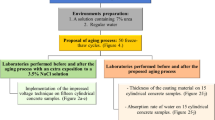Abstract
The ability of cementitious and acrylic coatings to protect concrete against carbonation was investigated by subjecting coated and uncoated samples to accelerated UV loads and subsequently measuring accelerated carbonation. Based on the correlation between accelerated and equivalent natural carbonation an equivalent oxygen permeability index (OPI) value was calculated for the coated samples using previously established correlations between carbonation and oxygen permeability. The OPI in turn was used as an input parameter in a performance-based carbonation prediction model, which resulted in the quantification of additional service life offered by the various coatings, depending on cover depth and exposure condition.






Similar content being viewed by others
References
Torrent R, Ebensperger L (2012) Measurement of the air permeability of concrete “in situ”: status quo. In: Proceedings of the 3rd international conference on concrete repair, rehabilitation and retrofitting, Cape Town 2012. Taylor and Francis Group, London. ISBN 978-0-415-89952-9, pp 302–308
Jacobs F, Denariè E, Leemann A, Teruzzi T (2009) Empfehlungen zur Qualitätskontrolle von Beton mit Luftpermeabilitätsmessungen. VSS Report 641. Office Fédéral des Routes, Bern
Mackechnie J, Alexander M (2002) Durability predictions using early age durability index testing. In 9th durability and building materials conference, Brisbane, 2002. Australian Corrosion Association
Alexander MG, Beushausen H (2008) Performance-based durability testing, design and specification in South Africa: latest developments. International conference on excellence in concrete construction through innovation, London, UK, 9–10 September 2008, CRC Press, pp 429–434
BS EN 206-1 (2000) Concrete—part 1: specification, performance, production and conformity
Alexander MG, Mackechnie JR, Ballim Y (2001) Use of durability indexes to achieve durable cover concrete in reinforced concrete structures. In: Skalny JP, Mindess S (eds) Materials science of concrete, vol VI. American Ceramic Society, pp 483–511
Beushausen H, Alexander M (2009) ‘Application of durability indicators for quality control of concrete members—a practical example’, RILEM Conference on Concrete in Aggressive Aqueous Environments, 3–5 June 2009. Toulouse, France, pp 548–556
Nganga G, Alexander MG, Beushausen H (2013) Practical implementation of the durability index performance-based design approach. Constr Build Mater. http://www.sciencedirect.com/science/article/pii/S0950061813002791
Concrete Society UK (1997) Technical Report no. 50. Guide to surface treatments for protection and enhancement of concrete. Published in the ACI Concrete Repair Manual, 2nd edn, vol 2, pp 1455–1536
ACI Concrete Repair Manual, 2nd edition, 2002. ISBN 0-87031-105-0, 2093 pp
Nieuwoudt P, Zaffaroni P, Pistolesi C (2012) Case history of polymer-modified cementitious membrane use to protect new and repair concrete. In: Proceedings of the 3rd international conference on concrete repair, rehabilitation and retrofitting, Cape Town 2012. Taylor and Francis Group, London. ISBN 978-0-415-89952-9, pp 932–937
Wei W, Rothwell G, Davies H (1989) Investigation of the gas and vapour resistance of surface coatings on concrete and effects of weathering on their carbonation protective performance. Shanghai Research Institute for Building Sciences
Raupach M, Wolff L (2006) Surface protection systems for concrete: investigations on durability and efficiency. In: Proceedings of the 1st international conference on concrete repair, rehabilitation and retrofitting, Cape Town 2005. Taylor and Francis Group, London. ISBN 0415396549, pp 137–143
ASTM G154-06 (2006) Standard practice for operating fluorescent light apparatus for UV exposure of non-metallic materials. Book of standards ASTM international committee G03.03 on simulated and controlled exposure tests 14.04
Bassi R, Roy SK (eds) (2002) Handbook of coatings for concrete. Whittles Publishing, Scottland. ISBN 1-870325-82-6, 241 pp
Beushausen H, Alexander MG, Mackechnie J (2003) Concrete durability aspects in an international context. Concrete plant and precast technology BFT, vol 7. Germany, pp 22–32
Torrent R, Fernández Luco L (eds) (2007) State of The Art Report (STAR): RILEM TC 189-NEC: non-destructive evaluation of the covercrete. Zurich, Switzerland, 223 pp
de Jong B (1973) Net radiation received by a horizontal surface at the earth. Delft University Press, Delft
SARERD (1999) Annual solar radiation map for South Africa. South African renewable energy resource database. Online: http://www.sabregen.co.za/sarerd%20database/solar.htm (25 January 2011)
Martin D (2005) Advanced thin film geomembrane technology. Remediation technologie symposium (RemTech 2005). Online: http://www.esaa-events.com/remtech/2005/default.htm (25 January 2011)
Grossman G (1977) Correlation of laboratory to natural weathering. J Coat Technol 49(633):45–54
Papadakis V, Vayenas C, Fardis M (1989) A reaction engineering approach to the problem of concrete carbonation. AIChE J 35(10):1639–1650
Acknowledgments
The authors wish to acknowledge with gratitude the following for financial support of this work: The Cement and Concrete Institute (C&CI), The National Research Foundation (NRF), and Sika (SA) Pty Ltd. In addition, support was given by Afrisam and PPC.
Author information
Authors and Affiliations
Corresponding author
Rights and permissions
About this article
Cite this article
Beushausen, H., Burmeister, N. The use of surface coatings to increase the service life of reinforced concrete structures for durability class XC. Mater Struct 48, 1243–1252 (2015). https://doi.org/10.1617/s11527-013-0229-8
Received:
Accepted:
Published:
Issue Date:
DOI: https://doi.org/10.1617/s11527-013-0229-8




